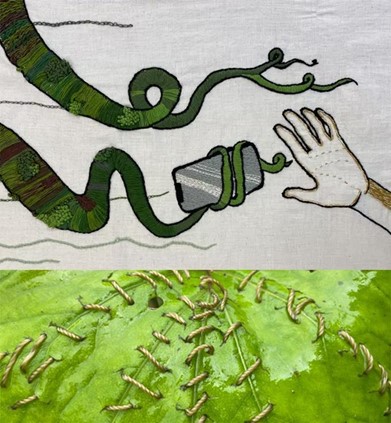Embodied eco-embroidery
Creative craftsmanship in sustainable STEAM-education
DOI:
https://doi.org/10.7577/ar.5339Keywords:
embroidery, quality education, transdisciplinary, craftsmanship, STEAM-educationAbstract
The UN Sustainable Development Goal 4 (SDG4) addresses equal access to quality education, focusing on literacy, numeracy and the science-field STEM subjects (Science, Technology, Engineering, Mathematics), - seemingly forgetting the importance of developing practical skills like craftsmanship. STEAM includes Arts into STEM, where the arts represent several independent artistic forms including music, theater, dance, visual arts, crafts and so on.
In this article we focus on education for sustainable development through craftsmanship in embroidery. In a transdisciplinary collaboration that includes art, craftsmanship has its own innate value. Our research question is: In which ways can creative collaboration in embroidery enhance a sustainable STEAM education learning experience?
We attempt to find answers to this by looking into how STEAM collaboration may affect the ways we teach craftsmanship, and the challenges and opportunities of doing so in a holistic transdisciplinary project, with a focus on ecological sustainability.
Three groups of teacher-students help examine how crafts may contribute in building ecological awareness in themselves and an audience through conveying meaningful artistic narratives. Their embroideries were inspired by the UN’s Decade of Ecosystem Restoration. The results were shared through the Global Science Opera, an international STEAM-education initiative.
Our analysis of the research data is influenced by posthumanizing creativity, which emphasizes ethically contributing world citizenship through embodied, collaborative creativity between creator and creation. This journey of making and being made shows a reciprocal relationship between humans and non-humans. The slow-art of embroidery invites the students into an embodied dialogue with the materials, tools, techniques and the scientific topics in the transdisciplinary context. As researchers we wonder how this dialogue and in-depth experience affected the students’ attitudes and actions towards sustainability. We found that the data supports the embodied, co-creative embroidery process, that it improved the students' craft experience, as well as increased the understanding and respect for the challenges in the new eco-reality.
Cover image: Sewing in nature, on nature, with nature, about nature. Student work. Photos: Randi Veiteberg Kvellestad and Raquel Sans

Downloads
Published
How to Cite
Issue
Section
License
Copyright (c) 2023 Randi Veiteberg Kvellestad, Janne Iren Robberstad

This work is licensed under a Creative Commons Attribution 4.0 International License.
Authors who publish with this journal agree to the following terms:
- Authors retain copyright and grant the journal right of first publication with the work simultaneously licensed under a Creative Commons Attribution License that allows others to share the work with an acknowledgement of the work's authorship and initial publication in this journal.
- Authors are able to enter into separate, additional contractual arrangements for the non-exclusive distribution of the journal's published version of the work (e.g., post it to an institutional repository or publish it in a book), with an acknowledgement of its initial publication in this journal.
- Authors are permitted and encouraged to post their work online (e.g., in institutional repositories or on their website) prior to and during the submission process, as it can lead to productive exchanges, as well as earlier and greater citation of published work (See The Effect of Open Access).